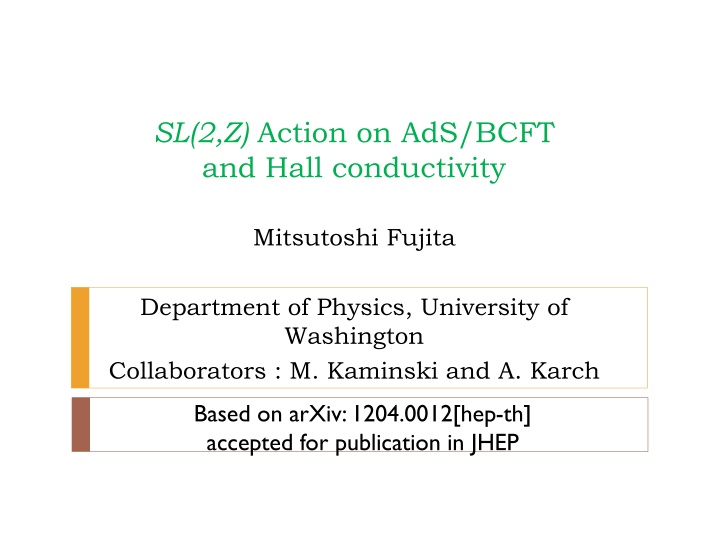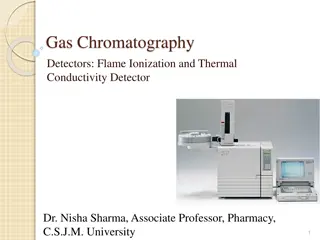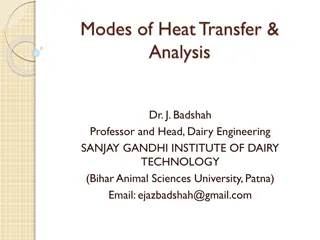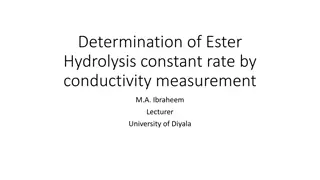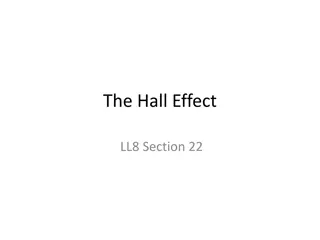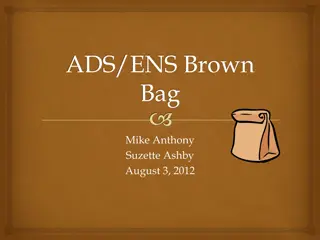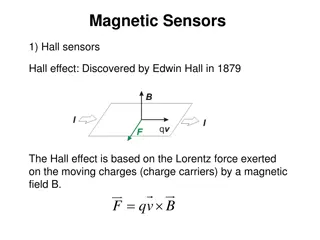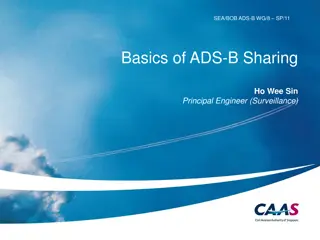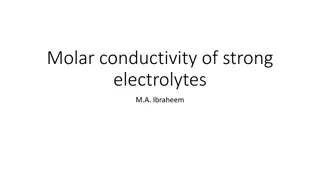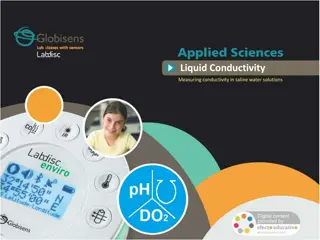SL(2,Z) Action on AdS/BCFT and Hall Conductivity
Introduction of boundaries in AdS/CFT, derivation of Hall current via AdS/BCFT, SL(2,Z) duality in AdS/CFT correspondence, gravity dual of BCFT and more in-depth analysis. Collaboration between Mitsutoshi Fujita and colleagues at University of Washington.
Download Presentation

Please find below an Image/Link to download the presentation.
The content on the website is provided AS IS for your information and personal use only. It may not be sold, licensed, or shared on other websites without obtaining consent from the author.If you encounter any issues during the download, it is possible that the publisher has removed the file from their server.
You are allowed to download the files provided on this website for personal or commercial use, subject to the condition that they are used lawfully. All files are the property of their respective owners.
The content on the website is provided AS IS for your information and personal use only. It may not be sold, licensed, or shared on other websites without obtaining consent from the author.
E N D
Presentation Transcript
SL(2,Z) Action on AdS/BCFT and Hall conductivity Mitsutoshi Fujita Department of Physics, University of Washington Collaborators : M. Kaminski and A. Karch Based on arXiv: 1204.0012[hep-th] accepted for publication in JHEP
Contents Introduction of boundaries in the AdS/CFT: the AdS/Boundary CFT (BCFT) Derivation of Hall current via the AdS/BCFT SL(2,Z) duality in the AdS/CFT correspondence: Review A duality transformation on AdS/BCFT Stringy realization
Introduction of boundaries in AdS/CFT The dynamics of strong-coupling theory can be solved using the AdS/CFT correspondence. Maldacena ``97 We want to add the defects and boundaries in CFT for the application to the condensed matter physics. Example: the boundary entropy, edge modes, a local quench
Introduction of boundaries in AdS/CFT We can introduce defect in the probe limit. Karch-Randall ``01 We understand the defect with backreaction in the context of Randall-Sundrum braneworlds (bottom-up model with thin branes). Randall-Sundrum, ``99 String theory duals to defects with backreacting defects and boundaries D Hoker-Estes-Gutperle, ``07 Aharony, Berdichevsky, Berkooz, and Shamir, ``11
Introduction to AdS/BCFT General construction for boundary CFTs and their holographic duals Takayanagi ``11 Fujita-Takayanagi-Tonni ``11 Based on the thin branes Including the orientifold planes, which in the context of string theory are described by thin objects with negative tension.
Gravity dual of the BCFT We consider the AdS4gravity dual on the half plane. The 4-dimensional Einstein-Hilbert action with the boundary term Isometry SO(2,2) in the presence of Q1 The boundary condition The AdS4metric This is restricted to the half plane y>0 at the AdS boundary.
Gravity dual of the BCFT The spacetime dual to the half-plane the vector normal to Q1pointing outside of the gravity region the vector parallel to Q1 l = , 0 , 0 ( sin , cos ) , 0 , 0 ( n 1 1 = cos , sin ) 1 1 K The extrinsic curvature and the tension T 2 / 2 / R T R , where . The ends of this interval are described by no defect.
Gravity dual of the BCFT Embedding of the brane various values of the tension. corresponding to 1is related with the boundary entropy! , 1 Just hard wall
The effective abelian action We introduce the effective abelian action The boundary term makes the action gauge invariant if 0 = x tA F = ( ) 0 d The solutions for the EOM: The boundary condition at Q1 : Neumann boundary condition With the boundary condition 1= 0 tA The solutions to the boundary condition Q
The GKPW relation The current density derived using the GKPW relation Gubser-Klebanov- -Polyakov ``98 Witten ``98 3 independent boundary conditions and the AdS boundary conditions determine the current. Describing the position independent gap and the standard Hall physics The conductivity becomes for setting For and , 2 / 1 = FQHE 1= k 2 0 k 2 = = t x , J B J E y
Dirichlet boundary condition on Q1 We choose the different boundary condition at Q1 Rewritten as The current at the AdS boundary Vanishing Jy Cf. B appears in the second order of the hydrodynamic expansion for T>>0. The Hall conductivity
Generalized and transport coefficients The most general constant field strength satisfies the condition at the boundary Q and the condition = 0 tA Q yx , 0 gives non-zero off-diagonal conductivities xy Non-trivial relations of coefficients t is present in any theory with a mass gap . Relation of Hall physics
Novel transport coefficients Do we satisfy onsager relations? if Parameters breaking time reversal The gradient of the condensate gives rise to B dependent term Bhattacharyya et al. ``08 Following effective theory realizes the above relation.
A duality transformation of D=2 electron gas and the discrete group SL(2,Z)
D=1+2 electron gas in a magnetic field Consider the d=1+2 electron gas in a magnetic field low temperature ~ 4K suppression of the phonon excitation Strong magnetic field B~ 1- 30 T states of the electron is approximately quantized via the Landau level The parameters of electron gas are the electron density and the magnetic flux. Filling fraction =(2 )Jt/B
The duality transformation in the d=2 electron gas The states of different filling fractions =(2 )Jt/B are related by (i) , 1 for + Landau level addition 1 , 1 (ii) Particle-hole transition 1 1 + , 2 (iii) Flux-attachment Girvin ``84, Jain-Kivelson-Trivedi ``93, Jain-Goldman ``92 transforms under the subgroup 0(2) SL(2,Z) like the complex coupling S ) 2 ( 0 2 , ST T
SL(2,Z) duality in the AdS/CFT correspondence
Interpretation of SL(2,Z) in the gravity side We consider 4-dimensional gravity theory on AdS4 with the Maxwell field. + = 2 2 dz d x 2 2 ds R 2 z Its conformal boundary Y at z=0 A The standard GKPW relation fixes a gauge field at Y The path integral with boundary conditions is interpreted as the generation functional in the CFT side exp( A Y 3 ) i d x J
Interpretation of S-transformation in the gravity side The 3d mirror symmetry The S duality in the bulk Maxwell theory Witten``03 B E E B , , = The S transformation in SL(2,Z) maps and the gauge field to . Here, A A = B F E F i i ijk jk zi A The standard AdS/CFT in terms of is equivalent in terms of the original to using a boundary condition instead of fixed 0 = E A A Only one linear combination of net electric and magnetic charge corresponds to the conserved quantity in the boundary.
Interpretation of T-transformation in the gravity side The generator T in SL(2,Z) corresponds to a 2 shift in the theta angle. After integration by parts, it transforms the generating function by Chern-Simons term. i A J A J Y Y 3 3 3 ijk exp( ) exp( ) exp( ) i d x i d x d x A A i j k 4 w 3 ( ) A contact term ~ is added to the correlation functions. x y ijk j 2 x
A duality transformation on AdS/BCFT The d=4Abelian action has the SL(2,R) symmetry Should be quantized to SL(2,Z) for superstring = c Defining the coupling constant , 4 ( ) c i 2 1 Here, is the 4-dimensional epsilon symbol and The SL(2,Z) transformation of The transformation is accompanied with that of the gauge field.
A duality transformation on AdS/BCFT Introduction of the following quantity Simplified to , where is invariant under the transformation of and following transformation or
A duality transformation on AdS/BCFT After the SL(2,Z) duality, the coupling constant and the gauge field are transformed to the dual values. , , , 2 1 B E c c , ' 1 c ' , , ' ' c E B 2 In the case of , the S transformation gives 2 / 1 = After the T transformation, c + 1 /( 4 ) c 2 2 The same action is operated for the case of the Dirichlet boundary condition at Q1.
Stringy realization of the Abelian theory Type IIA string theory on AdS4*CP3are dual to the d=3 N=6 Chern-Simons theory (ABJM theory) Aharony-Bergman-Jafferis-Maldacena ``08 Introduction of orientifold 8-planes can realize the AdS/BCFT. Fujita-Takayanagi-Tonni ``11 The 10-dimensional metric of AdS4*CP3 8 chiral fermions for each boundary The orientifold projection: y -y even under the orientifold : , g, C1, odd under it: B2, C3
Stringy realization After dimensional reduction to d=4, we obtain the Abelian action of the massless gauge fields = A C 3 ( , , ) AdS m n CP mn 4 2 R 12 M 4 + * F F F F M/k: number of B2flux 2 k for no O-planes, Hikida-Li-Takayanagi ``09 satisfying the Dirichlet boundary condition at the boundaries. Dirichlet b.c. Cf. Neumann b.c. F F y y O8- O8-
Stringy realization This system realizes the FQHE and the Hall conductivity xy=M/2 k Vanishing longitudinal conductivity! The SL(2,Z) action of xy
Discussion We analyzed the response of a conserved current to external electromagnetic field in the AdS/BCFT correspondence. This allows us to extract the Hall current. Analysis of the action of a duality transformation String theory embedding of the abelian theory
Future direction Application to the BH solution with the boundary breaking the translation invariance Analysis of the (1+1)-dimensional boundary states Using the AdS3/dCFT2correspondence and the Yang-Mills- Chern-Simons theory (working in progress) The presence of the anomalous hydrodynamic mode at the finite temperature = # JA F
Modular Action on Current 2-point function S operation has been studied in the case of Nffree fermions with U(1) gauge group for large Nf Borokhov-Kapustin-Wu ``02 The effective action becomes weak coupling proportional to 1 N f The large Nftheory has the property that the current has nearly Gaussian correlations Complex coupling (t>0) = w+ it
( ) CFT correlator of U 1 current in 2+1 dimensions J : a universal number analogous to the level number of the Kac-Moody algebra in 1+1 dimensions p p p ( ) p J ( ) 2 = J p K p 2 K: a universal number analogous to the level number of the Kac-Moody algebra in 1+1 dimensions Application of Kubo formula shows that 4 2 h 2 e = K
Modular Action on Current 2-point function The effective action of Aiafter including gauge fixing kiAi=0 The propagator of Aiis the inverse of the matrix ~ J The current of the theory transformed by S: = ( ) ( 2 / i ) ( ) k k A k i ijr j r -1/ compared with <J J> ~k Ji The 2-point function of ( )
Action of SL(2,Z) on CFT S transformation is used to describe the d=3 mirror symmetry. Kapustin-Strassler ``99 2 / ( ) ( i k J i = ~ Defining the current of the dual theory the action after S-transformation becomes ) ( ) k A k ijr j r T action adds the Chern-Simons action 1 ~ ~ + ijk ( , ) ( , ) L A L A A A i j k 4
